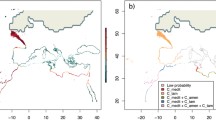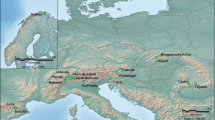Abstract
Adaptive radiation is the diversification of a founding population into multiple taxa that are differentially adapted to diverse ecological niches. The three Callicarpa (Lamiaceae) species endemic to the Bonin Islands are considered to represent an example of adaptive radiation on oceanic islands. All three species are distributed in the Chichijima Island Group and grow in different habitats, while only one species, C. subpubescens, is distributed among other island groups. Particularly, in the Hahajima and Mukojima Island Groups, C. subpubescens grows in various habitats and shows relatively high morphological variation. We investigated genotypes of the three Callicarpa species at 14 microsatellite markers to elucidate genetic differentiation within and between species or island groups and between different habitats or morphologies. We found that genetic differentiation within C. subpubescens in the Hahajima and Mukojima Island Groups was equally as high as that between the three species in the Chichijima Island Group, while differentiation within C. subpubescens in the Chichijima Island Group was much lower. Analyses such as a Bayesian clustering analysis showed that genetically distinct groups were associated with the three species in the Chichijima Island Group, whereas they showed strong genetic structure within C. subpubescens in the Hahajima and Mukojima Island Groups among different habitats and morphologies. These results indicated that ecological diversification occurred in the Hahajima and Mukojima Island Groups. Meanwhile, high genetic differentiation among different island groups was also observed, reflecting isolation by distance. It implies that non-ecological factors such as geographic isolation also played important roles in genetic differentiation in Callicarpa species in the Bonin Islands. These findings suggest that the Callicarpa species in the Bonin Islands are differentiated into multiple genetic groups by both ecological and non-ecological factors.






Similar content being viewed by others
References
Anderson B, Alexandersson R, Johnson SD (2010) Evolution and coexistence of pollination ecotypes in an African Gladiolus (Iridaceae). Evolution 64:960–972. https://doi.org/10.1111/j.1558-5646.2009.00880.x
Barrett SCH (1996) The reproductive biology and genetics of island plants. Philos Trans R Soc Lond B Biol Sci 351:725–733. https://doi.org/10.1098/rstb.1996.0067
Coyne JA, Orr HA (2004) Speciation. Sinauer Associates, Massachusetts
Crosby JL (1970) The evolution of genetic discontinuity: computer models of the selection of barriers to interbreeding between subspecies. Heredity 25:253–297. https://doi.org/10.1038/hdy.1970.30
Doyle J, Doyle J (1987) A rapid DNA isolation procedure for small quantities of fresh leaf tissue. Phytochem Bull 19:11–15
El Mousadik A, Petit RJ (1996) High level of genetic differentiation for allelic richness among populations of the argan tree Argania spinosa (L) Skeels endemic to Morocco. Theor Appl Genet 92:832–839. https://doi.org/10.1007/BF00221895
Emerson BC (2002) Evolution on oceanic islands: molecular phylogenetic approaches to understanding pattern and process. Mol Ecol 11:951–966. https://doi.org/10.1046/j.1365-294X.2002.01507.x
Evanno G, Regnaut S, Goudet J (2005) Detecting the number of clusters of individuals using the software structure: a simulation study. Mol Ecol 14:2611–2620. https://doi.org/10.1111/j.1365-294X.2005.02553.x
Excoffier L, Laval G, Schneider S (2005) Arlequin ver. 3.0: an integrated software package for population genetics data analysis. Evol Bioinform Online 1:47–50. https://doi.org/10.1177/117693430500100003
Falush D, Stephens M, Pritchard JK (2003) Inference of population structure using multilocus genotype data: linked loci and correlated allele frequencies. Genetics 164:1567–1587
Falush D, Stephens M, Pritchard JK (2007) Inference of population structure using multilocus genotype data: dominant markers and null alleles. Mol Ecol Notes 7:574–578. https://doi.org/10.1111/j.1471-8286.2007.01758.x
Friar EA, Prince LM, Roalson EH, McGlaughlin ME, Cruse-Sanders JM, De Groot SJ, Porter JM (2006) Ecological speciation in the East Maui-endemic Dubautia (Asteraceae) species. Evolution 60:1777–1792. https://doi.org/10.1111/j.0014-3820.2006.tb00522.x
Gavrilets S, Vose A (2007) Case studies and mathematical models of ecological speciation. 2. Palms on an oceanic island. Mol Ecol 16:2910–2921. https://doi.org/10.1111/j.1365-294X.2007.03304.x
Gillespie RG, Howarth FG, Roderick GK (2001) Adaptive Radiation. In: Levin SA (ed) Encyclopedia of biodiversity, vol 1. Academic Press, New York, pp 25–44
Givnish TJ (1997) Adaptive radiation and molecular systematics: issues and approaches. In: Givnish TJ, Sytsma KJ (eds) Molecular evolution and adaptive radiation. Cambridge University Press, Cambridge, pp 1–54
Givnish TJ (2010) Ecology of plant speciation. Taxon 59:1326–1366. https://doi.org/10.1002/tax.595003
Goudet J (2002) Fstat v2. 9.3.2. http://www2.unil.ch/popgen/softwares/fstat.htm. Accessed July 2018
Ito M, Ono M (1990) Allozyme diversity and the evolution of Crepidiastrum (Compositae) on the Bonin (Ogasawara) Islands. Bot Mag Tokyo 103:449–459. https://doi.org/10.1007/BF02491263
Ito M, Soejima A, Ono M (1997) Allozyme diversity of Pittosporum (Pittosporaceae) on the Bonin (Ogasawara) Islands. J Plant Res 110:455–462. https://doi.org/10.1007/BF02506806
Ito M, Soejima A, Ono M (1998) Genetic diversity of the endemic plants of the Bonin (Ogasawara) Islands. In: Stuessy TF, Ono M (eds) Evolution and speciation of island plants. Cambridge University Press, Cambridge, pp 141–154
Izuno A, Kitayama K, Onoda Y, Tsujii Y, Hatakeyama M, Nagano AJ, Honjo MN, Shimizu-Inatsugi R, Kudoh H, Shimizu KK, Isagi Y (2017) The population genomic signature of environmental association and gene flow in an ecologically divergent tree species Metrosideros polymorpha (Myrtaceae). Mol Ecol 26:1515–1532. https://doi.org/10.1111/mec.14016
Kato M, Shibata A, Yasui T, Nagamasu H (1999) Impact of introduced honeybees, Apis mellifera, upon native bee communities in the Bonin (Ogasawara) Islands. Res Popul Ecol 41:217–228. https://doi.org/10.1007/s101440050025
Kawakubo N (1986) Morphological variation of three endemic species of Callicarpa (Verbenaceae) in the Bonin (Ogasawara) Islands. Plant Species Biol 1:59–68
Kawakubo N (1990) Dioecism of the genus Callicarpa (Verbenaceae) in the Bonin (Ogasawara) Islands. Bot Mag Tokyo 103:57–66. https://doi.org/10.1111/j.1442-1984.1986.tb00015.x
Kawakubo N (1998) Evolution of cryptic dioecy in Callicarpa (Verbenaceae) on the Bonin Islands. In: Stuessy TF, Ono M (eds) Evolution and speciation of island plants. Cambridge University Press, Cambridge, pp 155–168
Kitayama K, Pattison R, Cordell S, Webb D, Mueller-Dombois D (1997) Ecological and genetic implications of foliar polymorphism in Metrosideros polymorpha Gaud. (Myrtaceae) in a habitat matrix on Mauna Loa, Hawaii. Ann Bot 80:491–497. https://doi.org/10.1006/anbo.1996.0473
Kobayashi S (1978) A list of the vascular plants occurring in the Ogasawara (Bonin) Islands. Ogasawara Res 1:1–33
Langella O (1999) Populations, 1.2.30. http://bioinformatics.org/populations/. Accessed July 2018
Losos JB, Jackman TR, Larson A, de Queiroz K, Rodriguez-Schettino L (1998) Contingency and determinism in replicated adaptive radiations of island lizards. Science 279:2115–2118. https://doi.org/10.1126/science.279.5359.2115
Mantel N (1967) The detection of disease clustering and a generalized regression approach. Cancer Res 27:209–220
Marques I, Rossello-Graell A, Draper D, Iriondo JM (2007) Pollination patterns limit hybridization between two sympatric species of Narcissus (Amaryllidaceae). Am J Bot 94:1352–1359. https://doi.org/10.3732/ajb.94.8.1352
Martin NH, Willis JH (2007) Ecological divergence associated with mating system causes nearly complete reproductive isolation between sympatric Mimulus species. Evolution 61:68–82. https://doi.org/10.1111/j.1558-5646.2007.00006.x
Ministry of the Environment Government of Japan (2018) Red list 2018 on Ministry of the Environment, Government of Japan. https://www.env.go.jp/press/files/jp/109278.pdf. Accessed 11 Oct 2018 (in Japanese)
Mori K, Kaneko S, Isagi Y, Murakami N, Kato H (2008) Isolation and characterization of 10 microsatellite loci in Callicarpa subpubescens (Verbenaceae), an endemic species of the Bonin Islands. Mol Ecol Resour 8:1423–1425. https://doi.org/10.1111/j.1755-0998.2008.02194.x
Nei M, Tajima F, Tateno Y (1983) Accuracy of estimated phylogenetic trees from molecular data. II. Gene frequency data. J Mol Evol 19:153–170
Nosil P, Vines TH, Funk DJ (2005) Perspective: reproductive isolation caused by natural selection against immigrants from divergent habitats. Evolution 59:705–719. https://doi.org/10.1554/04-428
Nybom H (2004) Comparison of different nuclear DNA markers for estimating intraspecific genetic diversity in plants. Mol Ecol 13:1143–1155. https://doi.org/10.1111/j.1365-294X.2004.02141.x
Ono M (1991) The flora of the Bonin (Ogasawara) Islands. Aliso 13:95–105. https://doi.org/10.5642/aliso.19911301.04
Peakall R, Smouse PE (2012) GenAlEx 6.5: genetic analysis in Excel. Population genetic software for teaching and research—an update. Bioinformatics 28:2537–2539. https://doi.org/10.1093/bioinformatics/bts460
Pritchard J, Stephens M, Donnelly P (2000) Inference of population structure using multilocus genotype data. Genetics 155:945–959
Rousset F (1997) Genetic differentiation and estimation of gene flow from F-statistics under isolation by distance. Genetics 145:1219–1228
Rundell RJ, Price TD (2009) Adaptive radiation, nonadaptive radiation, ecological speciation and nonecological speciation. Trends Ecol Evol 24:394–399. https://doi.org/10.1016/j.tree.2009.02.007
Rundle HD, Nosil P (2005) Ecological speciation. Ecol Lett 8:336–352. https://doi.org/10.1111/j.1461-0248.2004.00715.x
Sakaguchi S, Horie K, Ishikawa N, Nagano AJ, Yasugi M, Kudoh H, Ito M (2017) Simultaneous evaluation of the effects of geographic, environmental and temporal isolation in ecotypic populations of Solidago virgaurea. New Phytol 216:1268–1280. https://doi.org/10.1111/nph.14744
Saro I, Gonzalez-Perez MA, Garcia-Verdugo C, Sosa PA (2015) Patterns of genetic diversity in Phoenix canariensis, a widespread oceanic palm (species) endemic from the Canarian archipelago. Tree Genet Genomes 11:815. https://doi.org/10.1007/s11295-014-0815-0
Savolainen V, Anstett MC, Lexer C, Hutton I, Clarkson JJ, Norup MV, Powell MP, Springate D, Salamin N, Baker WJ (2006) Sympatric speciation in palms on an oceanic island. Nature 441:210–213. https://doi.org/10.1038/nature04566
Schluter D (2000) The ecology of adaptive radiation. Oxford University Press, Oxford
Shimizu Y, Tabata H (1991) Forest structures, composition, and distribution on a Pacific island, with reference to ecological release and speciation. Pac Sci 45:28–49
Soejima A, Nagamasu H, Ito M, Ono M (1994) Allozyme diversity and the evolution of Symplocos (Symplocaceae) on the Bonin (Ogasawara) Islands. J Plant Res 107:221–227. https://doi.org/10.1007/BF02344248
Stam P (1983) The evolution of reproductive isolation in closely adjacent plant populations through differential flowering time. Heredity 50:105–118. https://doi.org/10.1038/hdy.1983.13
Sugai K, Setsuko S, Nagamitsu T, Murakami N, Kato H, Yoshimaru H (2013) Genetic differentiation in Elaeocarpus photiniifolia (Elaeocarpaceae) associated with geographic distribution and habitat variation in the Bonin (Ogasawara) Islands. J Plant Res 126:763–774. https://doi.org/10.1007/s10265-013-0571-5
Takayama K, Sun BY, Stuessy TF (2013) Anagenetic speciation in Ullung Island, Korea: genetic diversity and structure in the island endemic species, Acer takesimense (Sapindaceae). J Plant Res 126:323–333. https://doi.org/10.1007/s10265-012-0529-z
Takayama K, Lopez-Sepulveda P, Greimler J, Crawford DJ, Penailillo P, Baeza M, Ruiz E, Kohl G, Tremetsberger K, Gatica A, Letelier L, Novoa P, Novak J, Stuessy TF (2015) Genetic consequences of cladogenetic vs anagenetic speciation in endemic plants of oceanic islands. Aob Plants. https://doi.org/10.1093/aobpla/plv102
R Core Team (2017) R: a language and environment for statistical computing, version 3.4.3. R Foundation for Statistical Computing, Vienna
Tokyo Metropolitan Government (2011) 2011 Red list of threatened species in Tokyo: Islands version, Tokyo (in Japanese)
Tsuneki S, Kato H, Murakami N (2014) Ecological and genetic differentiation in Persea boninensis (Lauraceae) endemic to the Bonin (Ogasawara) Islands. Plant Species Biol 29:16–24. https://doi.org/10.1111/j.1442-1984.2012.00383.x
Van Dijk P, Bijlsma R (1994) Simulations of flowerin time displacement between 2 cytotypes that form inviable hybrids. Heredity 72:522–535. https://doi.org/10.1038/hdy.1994.70
Weir BS, Cockerham CC (1984) Estimating F-statistics for the analysis of population-structure. Evolution 38:1358–1370
Whittaker RJ, Fernandez-Palacios JM (2007) Island evolution. In: Whittaker RJ, Fernandez-Palacios JM (eds) Island biogeography: ecology, evolution, and conservation. Oxford University Press, Oxford, pp 165–248
Wright S (1943) Isolation by distance. Genetics 28:114–138
Yamazaki T (1993) Callicarpa L. In: Iwatsuki K, Yamazaki T, Boufford DE, Ohba H (eds) Flora of Japan IIIa. Kodansha Ltd., Tokyo, pp 264–268
Acknowledgements
This work was partly supported by Grants-in-Aid for Science Research (20241056 to HK and NM, 18370038 to HK) from the Japanese Society for Promotion of Science and an intramural grant from the Faculty of Life and Environmental Sciences in Shimane University. We thank Drs. Y. Isagi, S. Kaneko, and S. Setsuko for valuable comments. We are also grateful to Tokyo Metropolitan Government, Ministry of Environmental Government of Japan, and Forestry Agency of Japan for allowing us to perform this study. We would like to thank Enago (http://www.enago.jp) for the English language review and the two anonymous reviewers for their valuable suggestions. This research was conducted using Tokyo Metropolitan University Ogasawara Field Research Station.
Author information
Authors and Affiliations
Corresponding author
Additional information
Publisher's Note
Springer Nature remains neutral with regard to jurisdictional claims in published maps and institutional affiliations.
Rights and permissions
About this article
Cite this article
Sugai, K., Mori, K., Murakami, N. et al. Strong genetic structure revealed by microsatellite variation in Callicarpa species endemic to the Bonin (Ogasawara) Islands. J Plant Res 132, 759–775 (2019). https://doi.org/10.1007/s10265-019-01144-4
Received:
Accepted:
Published:
Issue Date:
DOI: https://doi.org/10.1007/s10265-019-01144-4




